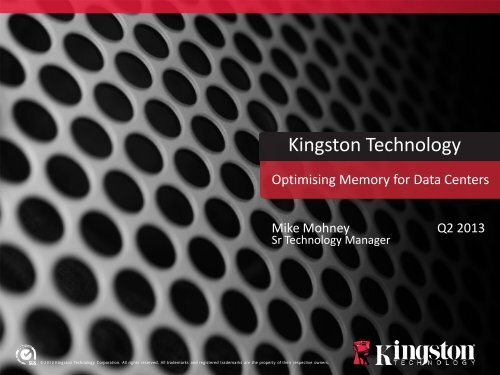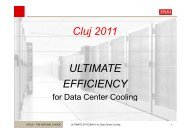Understanding the importance of proper memory configuration for ...
Understanding the importance of proper memory configuration for ...
Understanding the importance of proper memory configuration for ...
Create successful ePaper yourself
Turn your PDF publications into a flip-book with our unique Google optimized e-Paper software.
Kingston Technology<br />
Optimising Memory <strong>for</strong> Data Centers<br />
Mike Mohney Q2 2013<br />
Sr Technology Manager<br />
©2012 Kingston Technology Corporation. All rights reserved. All trademarks and registered trademarks are <strong>the</strong> <strong>proper</strong>ty <strong>of</strong> <strong>the</strong>ir respective owners.
Kingston Snapshot<br />
• Founded in 1987<br />
• Privately Held Company<br />
• Financially Secure<br />
• 2012 Net Revenue <strong>of</strong> over $4 Billion<br />
• Over 40% Global Market Share<br />
• More than 4,700 Employees Worldwide<br />
• Worldwide Manufacturing & Testing<br />
• Focused Business:<br />
Memory Modules and Flash Products<br />
• Delivering over 1M units per day<br />
• Products distributed in 125 Countries and<br />
available in over 30,000 locations worldwide;<br />
widely accepted brand<br />
2
Strategic Alliances: Compatibility Check<br />
Kingston works with many facets <strong>of</strong> technology to ensure product compatibility and also teams with<br />
s<strong>of</strong>tware & entertainment leaders to add more value to Flash products.<br />
Industry Leading OS,<br />
S<strong>of</strong>tware, Hardware<br />
PC OEM’s Mo<strong>the</strong>rboard Manufacturers Value-added Content<br />
Source: Kingston Technology, April 2012<br />
3
Kingston Server Memory Dynamic Burn-In Testing<br />
100% dynamic module burn-in testing exceeds OEM specifications<br />
• Since 2004, Kingston has set a new <strong>memory</strong> reliability standard<br />
• Testing includes all DDR2 and DDR3 server <strong>memory</strong><br />
Testing simulates 3 months <strong>of</strong> heavy server use<br />
• 24 hours in Kingston-designed test chambers<br />
• Tested at 100° Celsius / 212° Fahrenheit and higher voltage<br />
• Every cell <strong>of</strong> every DRAM is continuously exercised<br />
Nearly eliminates Early Life Failures<br />
Launched in 2004<br />
DDR, DDR2, DDR3 server <strong>memory</strong><br />
Kingston<br />
Patented<br />
Kingston hold 29 patents related to <strong>memory</strong> testing<br />
*Kingston 6-month trial testing in 2004 showed that 90% <strong>of</strong> Early Life DRAM<br />
failures are now being screened at <strong>the</strong> factory – be<strong>for</strong>e shipment to customers.<br />
4
DDR3 Memory – The Mainstream Technology in 2010-2014+<br />
1987-<br />
1990<br />
FAST<br />
PAGE<br />
MODE<br />
EDO<br />
1997-<br />
1999 2000<br />
PC66<br />
PC100<br />
PC133<br />
RDRAM<br />
PC600<br />
PC700<br />
PC800<br />
2001-<br />
2002 2003<br />
DDR200<br />
DDR266<br />
DDR333<br />
DDR400<br />
RDRAM<br />
PC1066<br />
2004-<br />
2005 2006<br />
DDR2-400<br />
DDR2-533<br />
DDR2-667<br />
DDR2-800<br />
FB-DIMMs<br />
EU: RoHS/WEEE<br />
Compliance<br />
2007-<br />
2009<br />
DDR3-800<br />
DDR3-1066<br />
DDR3-1333<br />
2010-<br />
2012<br />
DDR3L 1.35V<br />
DDR3-1600<br />
DDR3-1866<br />
DDR3L-1600<br />
LRDIMM<br />
2013<br />
EU: RoHS II<br />
Compliance<br />
2014<br />
DDR3-2133<br />
DDR4-2133<br />
2015<br />
DDR4-2400<br />
DDR3 expected to top out at 2133MHz (JEDEC)<br />
• Voltages expected to drop as low as 1.25V (DDR3U)<br />
DDR4 (2014) expected to debut at 2133MHz and perhaps reach 4266MHz<br />
• Voltages planned are 1.2V - 1.05V
Servers have evolved, along with <strong>the</strong> complexity <strong>of</strong> <strong>memory</strong><br />
<strong>configuration</strong><br />
2000 2013<br />
• 4 Memory Slots<br />
• Maximum Memory:<br />
2 GB<br />
• Memory Configuration<br />
Option 4x512MB<br />
• 24 Memory Slots<br />
• Maximum Memory:<br />
768 GB<br />
• Multiple Memory<br />
Configuration options
Today, Server Memory Configuration is influenced by many things<br />
Technology:<br />
ECC UDIMM, ECC<br />
Reg or LRDIMM<br />
Speed:<br />
Memory<br />
CPU<br />
Module quantity<br />
Voltage:<br />
Business requirements: 1.5V or 1.35V<br />
power, per<strong>for</strong>mance, capacity Power budget<br />
Memory budget<br />
Channels: Single, dual,<br />
triple or quad<br />
Memory expertise<br />
DRAM<br />
manufacturing<br />
technology<br />
Processor<br />
Selection<br />
Ranks:<br />
1, 2 or 4<br />
Processor<br />
Generation<br />
Module capacity
Memory Configuration Options by Processor<br />
Memory Supported<br />
Memory Configuration<br />
Xeon 5500 Series Up to DDR3-1333 Triple-Channel = K3 kits<br />
Xeon 5600 Series<br />
Xeon E5 Series<br />
Xeon 6500 / 7500 / E7 Series<br />
Xeon W3500 / 3600 / E3 Series<br />
Up to DDR3-1333 /<br />
DDR3L<br />
Up to DDR3-1600<br />
DDR3-1066<br />
DDR3L on E7 Series<br />
Up to DDR3-1066<br />
DDR3L on W3600<br />
Triple-Channel = K3 kits<br />
Quad-channel = K4 kits<br />
Triple-channel = K3 kits<br />
Quad-channel = K4 kits<br />
Triple-channel = K3 kits<br />
Xeon LC3500 Up to DDR3-1066 Dual-channel = K2 kits<br />
Opteron 8400 / 2400 Series Up to DDR2-800 Dual-channel = K2 kits<br />
Opteron 6100 / 6200 Series<br />
Up to DDR3-1333 /<br />
DDR3L<br />
Quad-channel = K4 kits<br />
Opteron 4100 / 4200 Series DDR3 / DDR3L Dual-channel = K2 kits<br />
Note: This is not a complete list <strong>of</strong> lower-end processors used <strong>for</strong> entry-level 1P servers.<br />
8
Intel Xeon E5-2600 and E5-1600 Processors<br />
Processor Model<br />
Determines Memory<br />
Speed (Bandwidth)<br />
9<br />
Source: Intel.com
Module Types For Server Plat<strong>for</strong>ms (2009-2013+)<br />
Unbuffered ECC DIMM Registered DIMM Load Reduced DIMM<br />
E5 & 6200 Series Only<br />
• You can configure a server <strong>memory</strong> with ei<strong>the</strong>r:<br />
• Unbuffered ECC DIMMs – up to 8GB each* – For entry-level servers & workstations<br />
• Registered DIMMs – up to 32GB each* – For mid-range and higher-end servers & workstations<br />
• Load Reduced DIMMs – up to 32GB each – For faster maximum capacity plat<strong>for</strong>ms<br />
• Optimizing Memory:<br />
• Install <strong>memory</strong> in kits <strong>of</strong> identical modules according to <strong>memory</strong> architecture<br />
• Configure all processors <strong>the</strong> same way <strong>for</strong> most bandwidth<br />
Install ei<strong>the</strong>r all RDIMMs or all ECC UDIMMs or all LRDIMMs, cannot mix!<br />
Mixing DDR3 (1.5V) and DDR3L (1.35V) will default <strong>the</strong> <strong>memory</strong> to 1.5V.<br />
* Plat<strong>for</strong>ms may limit <strong>the</strong> number <strong>of</strong> Unbuffered ECC or Quad Rank modules that can be installed.<br />
10
Intel Reference – E5-2600 DDR3 RDIMM Memory Speeds<br />
1.5V<br />
Module Type<br />
(No Mixing in<br />
a Server)<br />
Registered<br />
DIMM<br />
(RDIMM)<br />
Module Ranks<br />
SR/DR=Single/Dual<br />
QR = Quad<br />
1 DIMM per<br />
Channel<br />
1 DPC<br />
2 DIMMs per<br />
Channel<br />
2 DPC<br />
3 DIMMs per<br />
Channel<br />
3DPC<br />
SR/DR 1600 1600 1066<br />
QR 1066 800 X<br />
Module Type<br />
(No Mixing in<br />
a Server)<br />
Registered<br />
DIMM<br />
(RDIMM)<br />
Module Ranks<br />
SR/DR=Single/Dual<br />
QR = Quad<br />
1 DIMM per<br />
Channel<br />
1DPC<br />
1.35V<br />
2 DIMMs per<br />
Channel<br />
2DPC<br />
3 DIMMs per<br />
Channel<br />
3DPC<br />
SR/DR 1333 1333 1.5V<br />
QR 800 800 X<br />
1DPC 2DPC 3DPC<br />
11
Intel Reference – E5-2600 DDR3 LRDIMM & ECC UDIMM Memory Speeds<br />
1.5V / 1.35V<br />
Module Type<br />
(No Mixing in a Server)<br />
Module Ranks<br />
SR/DR=Single/Dual<br />
QR = Quad<br />
1 DIMM per<br />
Channel<br />
1 DPC<br />
2 DIMMs per<br />
Channel<br />
2 DPC<br />
3 DIMMs per<br />
Channel<br />
3DPC<br />
Load Reduced<br />
DIMM<br />
(LRDIMM)<br />
QR at 1.5V 1333 1333 1066<br />
QR at 1.35V 1066 1066 1066<br />
1DPC 2DPC 3DPC<br />
1.5V 1.35V<br />
Module Type<br />
(No Mixing in a Server)<br />
System Configuration<br />
1 DIMM per<br />
Channel<br />
1 DPC<br />
2 DIMMs<br />
per Channel<br />
2 DPC<br />
3 DIMMs<br />
per Channel<br />
3DPC<br />
1 DIMM per<br />
Channel<br />
1 DPC<br />
2 DIMMs per<br />
Channel<br />
2 DPC<br />
3 DIMMs per<br />
Channel<br />
3DPC<br />
ECC<br />
Unbuffered<br />
DIMM<br />
(ECC UDIMM)<br />
4 Sockets Per<br />
Processor<br />
8/12 Sockets<br />
Per Processor<br />
1600 1333 X 1333 X X<br />
1333 1333 X 1333 1066 X<br />
12
Balancing <strong>the</strong> Xeon 5500/5600 with Memory<br />
4G<br />
2G<br />
8G<br />
4G<br />
2G<br />
2G<br />
8G<br />
2G<br />
Unbalanced<br />
Configuration<br />
Near-Balanced<br />
Configuration<br />
8G<br />
4G<br />
2G<br />
vs<br />
8G<br />
4G<br />
Balanced<br />
Configuration<br />
8G<br />
4G<br />
2G<br />
Ultimate bandwidth and per<strong>for</strong>mance<br />
All sockets identically populated<br />
Stream-Triad Bandwidth<br />
(MB/sec)<br />
30000<br />
20000<br />
10000<br />
0<br />
Unbalanced<br />
3 channels<br />
Up to 17%<br />
lower b/w <strong>for</strong><br />
unbalanced<br />
<strong>configuration</strong><br />
Balanced<br />
3 channels<br />
Source: Intel
Set your goals be<strong>for</strong>e you choose your <strong>memory</strong><br />
Capacity<br />
Virtualization<br />
SQL databases<br />
In-Memory databases<br />
Big data/HADOOP<br />
Per<strong>for</strong>mance<br />
Complex modeling<br />
Audio & video editing<br />
Banking trades<br />
Transactions/second<br />
Power<br />
Power draw<br />
Heat dissipation<br />
Cooling requirements<br />
…or a combination <strong>of</strong> all <strong>of</strong> <strong>the</strong> above
How can <strong>the</strong> right Server DRAM <strong>configuration</strong> help your business?<br />
Reduce power consumption<br />
Save 6% Power consumption<br />
budget per server just by<br />
using <strong>proper</strong> server <strong>memory</strong><br />
<strong>configuration</strong><br />
Server per<strong>for</strong>mance<br />
improvement <strong>for</strong> transactional<br />
or database servers<br />
Higher frequency <strong>memory</strong><br />
provides faster access to data or<br />
improved transaction times<br />
Improve server<br />
consolidation ratios<br />
Go from 7 to 30 Active VMs<br />
just by increasing your server<br />
<strong>memory</strong> configs from 192 to<br />
768GB.<br />
Delay hardware refresh<br />
expenses<br />
By using <strong>the</strong> highest capacity<br />
and speeds in <strong>the</strong> fewest<br />
available slots, <strong>the</strong> server has a<br />
future upgrade path when your<br />
environment requires a boost
Capacity Benchmark: Increasing capacity allows <strong>for</strong> more<br />
database virtual machines<br />
7 VMs<br />
with<br />
192 GB<br />
10 VMs<br />
with<br />
256 GB<br />
30 VMs<br />
with<br />
768 GB<br />
Testing done with 1vCPU and 25GB RAM per VM on an HP Proliant DL380p Gen 8. For details, please see benchmark paper<br />
http://www.kingston.com/us/business/server_solutions/ram_per<strong>for</strong>mance.aspx
Power Benchmark: Save 6% on your total server power budget<br />
Savings at load in Watts<br />
16X16GB=256GB<br />
8X32GB=256GB<br />
Test system: SiS<strong>of</strong>tware BurnInTest 7.1 Pro on Intel® Romley plat<strong>for</strong>m HP Proliant ML350p Gen8 with two Intel Xeon E5 2650 processors and up to 256GB, 384GB or 512GB <strong>of</strong> <strong>memory</strong> (Dualrank<br />
KTH-PL316/16G or quad-rank KTH-PL310QLV/32G) installed. Tested in HP per<strong>for</strong>mance mode. Intel Hyper-threading technology disabled.
Per<strong>for</strong>mance Benchmark:<br />
Per<strong>for</strong>mance Result:<br />
40%<br />
Increased sustained<br />
transfer speeds –<br />
Ideal <strong>for</strong> scenarios<br />
where resources<br />
written to <strong>memory</strong><br />
require highest<br />
achievable<br />
per<strong>for</strong>mance to<br />
remain efficient.<br />
Relative <strong>memory</strong> frequency per<strong>for</strong>mance measured using<br />
SiS<strong>of</strong>t Sandra 2012<br />
70<br />
60<br />
50<br />
40<br />
30<br />
20<br />
10<br />
0<br />
41,9<br />
54,5<br />
64,1<br />
69,7<br />
800MHz 1066MHz 1033MHz 1600MHz<br />
Test <strong>configuration</strong> included SiS<strong>of</strong>tware Sandra 2012 Memory benchmark on Intel® Romley plat<strong>for</strong>m S2600GZ with two Xeon E5-2665 2.40GHz processors and<br />
192GB <strong>of</strong> <strong>memory</strong> (2 x KVR16R11D4K4/32) installed. CPU Hyper-threading and power saving features disabled.
Server <strong>memory</strong> <strong>configuration</strong> optimisation<br />
These scenarios illustrate that all three<br />
objectives can not be optimised at <strong>the</strong> same<br />
time. Priority should be to support <strong>the</strong><br />
business objective.<br />
Scenario 1<br />
Power<br />
• Scenario 1 shows that <strong>for</strong> this<br />
business achieving power<br />
optimisation is critical, while<br />
per<strong>for</strong>mance is more important than<br />
capacity.<br />
Capacity<br />
Per<strong>for</strong>mance<br />
• Scenario 2 shows that achieving<br />
maximum capacity has a higher<br />
priority than power or per<strong>for</strong>mance<br />
optimisation.<br />
Scenario 2<br />
Power<br />
In addition, <strong>the</strong> actual cost <strong>of</strong> <strong>the</strong> <strong>memory</strong> still<br />
needs to be considered.<br />
Capacity<br />
Per<strong>for</strong>mance
Kingston is educating <strong>the</strong> market on <strong>the</strong>se <strong>configuration</strong>s
Kingston Summary<br />
• Ranked #1 in DRAM<br />
• Ranked #1 in USB drives<br />
• Listed on America’s largest private companies<br />
• Worldwide presence/financially solid<br />
• Channel leadership – OEM, channel, Retail, eTail<br />
• Major investments in technology<br />
• Seat on JEDEC standards council<br />
• R&D partnerships with ODMs, datacenters, and technology leaders<br />
• Most extensive testing in <strong>the</strong> industry<br />
• Guaranteed compatibility/certifications<br />
• Flat, flexible organization able to customize solutions <strong>for</strong> a variety <strong>of</strong> business relationships<br />
• Managing <strong>the</strong> quality process – from wafer to module<br />
21
22<br />
Thank You









